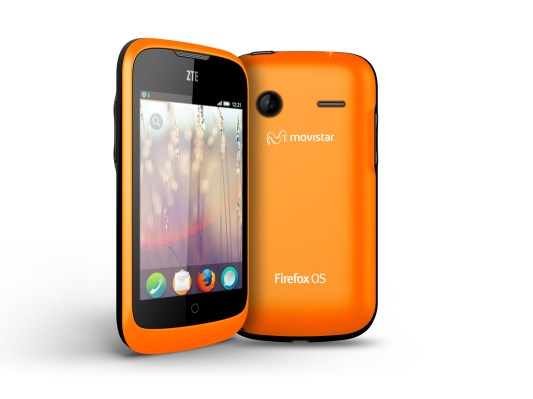The first phone running Mozilla’s Firefox OS phone goes on sale tomorrow in Spain. Mozilla’s nascent open web HTML 5 mobile platform has garnered considerable carrier support already, months ahead of any phones being launched, which just serves to underline the level of concern in the mobile industry about how dominant Google’s Android platform has become.
Smaller handset makers like ZTE and Alcatel are also unsurprisingly taking a punt on Firefox OS. What’s to lose? And with carrier pricing as low as Telefonica’s opening gambit of $90 (a price which includes around $40 worth of airtime for pre-pay customers) a degree of consumer uptake should follow — if only by gobbling up the remains of the feature phone market. As IHS Screen Digest analyst Ian Fogg tweeted today: “Now there’s no price reason not to own a smartphone.”
Feature phones still take considerable share in the emerging markets where Firefox OS is being aimed. And while Spain may seem an odd first choice to debut the OS the Spanish economy is having a very tough time of it at present, with unemployment riding high, especially among the young, so a budget smartphone is likely to find plenty of takers. In that crisis, Telefonica clearly perceives an opportunity.
BlackBerry’s low cost handsets have also traditionally done well with Spanish teens (and in emerging markets generally). So as that company puts its energies into higher end devices running its new BlackBerry 10 OS, there’s a gap opening up for another low cost smartphone to muscle in. Enter Firefox OS: perhaps the best chance yet for carriers to put a little clear blue water between the devices they peddle and Google’s Android at the low end.
How well Firefox OS performs on low end hardware will be key, as there are still question marks over HTML5’s ability to perform on mobile (Facebook famously switched back to native after failing to make HTML5’s performance stick), especially if you factor in the lower powered hardware Firefox OS is going for. These devices won’t need to be super slick, but they will need to be slick enough to compete with similarly budget Androids that are also constrained by their hardware.
After overall performance, app availability and performance are going to be essential. Apps like Facebook and Twitter have been optimised for Firefox OS already but Mozilla and its backers certainly have its work cut out to get in the game because Android has such a head start — and already plays at this budget price-point. “The challenge for Firefox OS, is that Android is already v v cheap & has lots of content available too,” as Fogg noted via Twitter.
That said, so long as enough key apps (like Facebook) are available — and if carriers bolster those app staples by helping to foster and promote localised app content to differentiate the devices — there is still room to stand out at a feature phone replacement price. It’s a similar strategy Nokia has been deploying with its Asha devices — which aren’t fully fledged smart phones but add in smartphone-like features (such as pre-loaded social network apps and baked in social sharing) to beef up their appeal to budget buyers.
The big question is how easy is developing and optimising apps for Firefox OS? One HTML5 app maker, Atlas CT, which makes a turn-by-turn sat-nav HTML5 app (called EverNav) has been working on its app for two years. It’s optimising EverNav for Firefox — with plans to release it on July 15, hoping to be the first turn-by-turn sat-nav for the OS.
“We began working on EverNav even prior to Mozilla’s announcement on HTML5 based OS. We estimated that having a true cross platform navigation solution will be a major advantage for mobile advertising and also for end users everyday navigation,” the company tells TechCrunch.
“We initially began by adding very basic turn by turn navigation to a mobile webpage. Later on in the development process we added features for both navigation and mobile advertising until we got the full featured application we are releasing. Naturally, we still have a long list of features that will be added in upcoming versions.”
When Mozilla announced Firefox OS in February, EverNav’s developers began work on a dedicated version for the platform — so that’s about a six-month additional development window on top of time already spent on their HTML 5 app. Still, this is not exactly a lightweight app. The company says developing such a time- and location-sensitive app in HTML 5 has definitely been challenging, describing its functionality as pushing HTML 5 to its current limits.
“Things that are trivial in native application development such as utilizing the GPS or running parallel processes are much harder to be done efficiently in HTML5,” it says. “Just to give you an example, one of the hardest tasks we had was to play sounds at exactly the right time to match the driving directions. Something that is extremely easy when developing native applications became a challenge in HTML5.”
With those challenges and limitations in mind, it will be interesting to see how Firefox apps fly: whether they can stand up to real-world use and abuse, how they manage with budget hardware — and most importantly whether HTML5 can hold its own against native Android equivalents at the low end.
